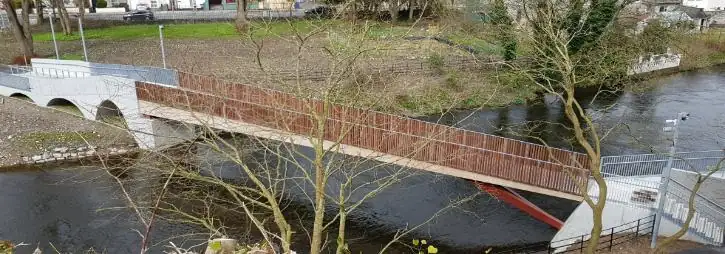- Home
- About
- Student Led
- Research Informed
- Practice Focused
- Resources
- Case Studies
- Green Labs Community
- News
- Office of Sustainability and Climate Action
Building Design at University College Cork
Building Design at University College Cork
UCC’s estate comprises of 295,000 m2 of buildings, 86 hectares of grounds and property and approximately 149 individual buildings.
The size, function and age of these 149 buildings varies across the Estate. From the 1800’s to 2016, the University is fortunate to have in its possession different building archetypes and it is the responsibility of the Building & Estates office to manage these many wonderful buildings.
Within this office, the Capital Projects department is responsible for delivering new buildings and managing projects that involve the significant refurbishment of our existing buildings.
UCC Building Design Policy
Guided by our internal design policies and guidelines as well as current statutory building regulations the University requires that all new buildings and significant refurbishment projects meet the Near Zero Energy Building (NZEB), achieve a minimum Building Energy Rating of A3 and a BREEAM Excellent Standard (https://www.breeam.com/).
From conceptual stage to construction and building operation Sustainability is considered at every phase in the project. The orientation and form of the building as well as the materials to be used are chosen at the concept stage and specified to give the most sustainable design for the purpose and location of the building. Designers are also tasked with achieving and/or incorporating as many Passive House Institute principle as possible into the building design.
Over the years the University has led the way in ambitious sustainable design, delivering award winning buildings like the Glucksman Gallery (http://www.glucksman.org/about/architecture) for its sustainable design and use of geothermal heat source in 2004.
The Western Gateway building, a winner of the SEAI Renewable Energy award in 2012 and the CIBSE Sustainable Design and Research award in 2011 is a 28,000 m2 4 storey building. The building uses a 1MW(th) Ground Source Heat Pump (GSHP) which provides heating & cooling to the building. Utilising waste heat from computer rooms combined together with a ground source heat pump, the buildings heating demands are met by the 40 KW(e) GSHP.
As the University continues to grow and expand the Estates office are constantly reviewing and updating its design documents to ensure that we remain at the forefront of sustainable design practices, promoting new technology and building design strategies to make our buildings more comfortable for the occupants while also hitting our sustainability goals.
The design and construction of new buildings is only one aspect of having a sustainable campus as without ongoing optimisation and maintenance of our buildings the original sustainable design intent of the building can be diminished. Through our ISO 50001 Energy Management System the University ensures that the buildings energy consumption is closely monitored and undergoes continuous optimisation and energy improvements.
Near Zero Energy Buildings – National & EU Policy
All new buildings constructed by public sector bodies in Ireland, including Universities, are required to comply with the national Nearly Zero Energy Building Regulations (S.I. No. 4/2017) which came into effect for public authorities on December 31 2018. ‘Nearly Zero – Energy Buildings’ are defined in Annex 1 of the EU ‘Energy Performance of Buildings Directive 2010/31/EU (EPBD)’ as amended by Directive 2018/844/EU (EPBD). They are defined as buildings that have a very high energy performance in which “the nearly zero or very low amount of energy required should be covered to a very significant extent by energy from renewable sources, including energy from renewable sources produced on-site or nearby“. For all public sector new builds, an equivalent to a 60% improvement in energy performance on the 2008 Building Regulations is required by law. This means an improved energy performance for the fabric, services and lighting specification. It also introduces a mandatory requirement for renewable sources.
Further details are available from the SEAI:
https://www.seai.ie/business-and-public-sector/standards/nearly-zero-energy-building-standard/
Landscape, Surface Waters & Biodiversity
In addition to energy, water and GHG efficiencies, all capital project and new builds at UCC take their impact on the landscape, surface waters and biodiversity into account in the design and planning phase. This is ensured through achieving BREEAM Excellent Standards which includes minimizing impacts on landscape & biodiversity standards, and through full compliance with national and international policy relating to Environmental Impact Assessment and Appropriate Assessment. UCC Campus is primarily located on the banks of the River Lee in Cork Harbour. The river, the harbour and the surrounding environs are home to a wide variety of habitats and species that are of conservation interest or protected by the law. Minimising any impact of our developments on sensitive habitats and species is thus a priority for UCC. For example, the recently opened Cavanagh Bridge over the River Lee South Channel on UCC Campus, was designed with the ecology of the local otter population in mind. Additional arches were included in the bridge so as not to impede otter runs as they move along the river bank.

The primary legal instruments for biodiversity conservation which UCC comply with in the planning process are the Habitats Directive (92/43/EEC) and the Birds Directive (2009/147/EC). The Birds Directive and Habitats Directive have been transposed into Irish law through S.I. No. 477 (2011). These directives seek to conserve natural habitats, flora and fauna through the designation of a network of Natura 2000 Sites (SAC/SPA). The Habitats Directive requires that any plan or project likely to have a significant effect on a Natura 2000 sites or species shall be subject to appropriate assessment of its implications for the site in view of the site’s conservation objectives. Similarly, Environmental Impact Directive (Directive 2011/92/EU; S.I. No. 296/2018) requires that any major plans must be assessed for their impact on natural resources, landscape, surface waters, habitats and biodiversity, amongst other things.
